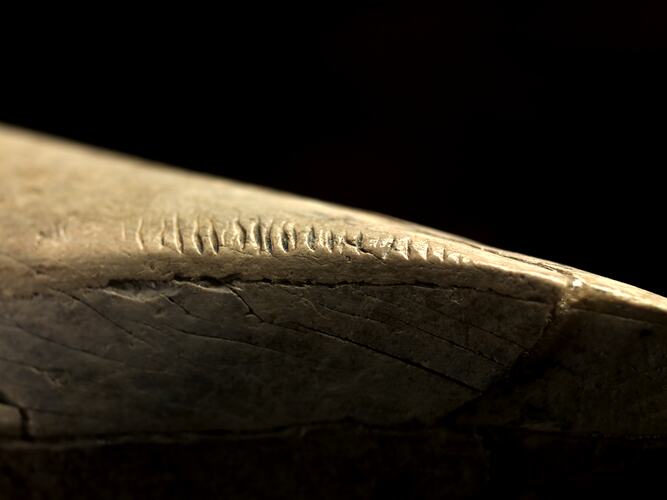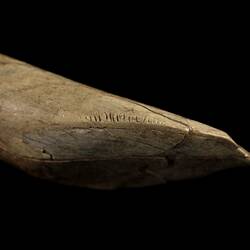Summary
This is a fossil upper tooth of the extinct giant marsupial, Diprotodon optatum. It was collected at Spring Creek near Minhamite, on Eastern Maar Country in southwestern Victoria, in January 1984. Diprotodon existed in Australia during the Pleistocene Epoch, from around 2.5 million years ago until around 40,000 years ago.
The linear grooves on the edge of this tooth were suggested at the time of its discovery to be markings engraved by an Aboriginal person. Members of First Peoples communities in Victoria have noted a similarity between the fossil's markings and the traditional patterns of linear carving practiced in the south east of Australia.
In 2020, the linear grooves on the tooth were closely compared to markings including grooves carved by people, as well as non-human sources such as scavenging animals. Differences in the materials used to make markings on objects, as well as how force is applied to the affected object, can create reliable differences in the shape of markings. This analysis identified the grooves as bite traces made by a small carnivore, most likely a Spotted-tailed Quoll.
At the time of its discovery, this fossil was a rare example of evidence indicating the co-presence of people and now-extinct megafauna in Pleistocene Australia. Since then, diverse archaeological evidence from across Australia shows a record of First Peoples and megafauna sharing this continent for at least tens of thousands of years.
Vanderwal, R., & Fullagar, R. (1989). Engraved Diprotodon tooth from the Spring Creek locality, Victoria. Archaeology in Oceania, 24(1), 13-16.
Langley, M.C. (2020). Re-analysis of the "engraved" Diprotodon tooth from Spring Creek, Victoria, Australia. Archaeology in Oceania. doi:10.1002/arco.5209
Specimen Details
-
Taxon Name
-
Author and date of publication
Owen, 1838
-
Number Of Specimens
1
-
Sex
Unknown
-
Date Collected From
/01/1984
-
Category
-
Scientific Group
-
Discipline
-
Collecting Areas
-
Type of Item
-
Keywords
Taxonomy
-
Kingdom
-
Phylum
-
Subphylum
-
Class
-
Superorder
-
Order
-
Family
-
Genus
-
Species Name
optatum
Geospatial Information
-
Continent
-
Country
-
State
-
District
-
Nearest Named Place
-
Era
Cenozoic
-
Period
Quaternary
-
Epoch
Pleistocene





